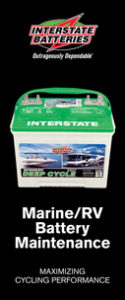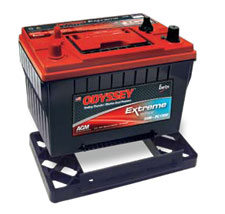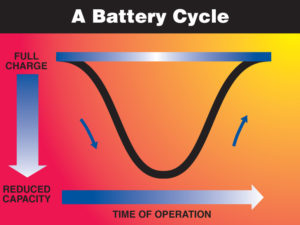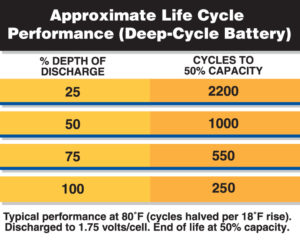RV & Marine Batteries
Interstate Deep Cycle Battery

There are many misunderstandings regarding Marine Batteries & RV Deep-Cycle batteries. This page is
designed to clarify terminology and misconceptions and to assist you, the customer, in:

1. making an informed decision regarding proper usage,
2. extending overall battery service life, and
3. maintaining battery performance at optimum levels.
Deep-Cycle Batteries
The term “deep cycle” refers, in general, to a battery that has the capability of deeply discharging hundreds of times. Deep-cycle marine batteries are either liquid electrolyte or sealed lead acid. How do they differ from other batteries? An automotive starting battery is manufactured specifically to provide a quick burst of energy thousands of times in its lifetime, while only being able to deeply discharge less than 50 cycles during its life.
Our experts make it easy to find just the right battery, but we can handle all your battery recycling needs as well! Come in today or submit our request an auto battery quote and we’ll do the research for you. If you already know exactly what you need you can order your automotive battery direct online for in-store pickup.
Sealed Lead-Acid Versus Flooded Lead-Acid
Marine/RV deep-cycle batteries are available in two different lead-acid types. A flooded or liquid-electrolyte
battery has vent caps to allow maintenance, and a sealed lead-acid battery is completely sealed or maintenance-free. Each is available in common battery group sizes and has similar ratings (CCA, RC, and Ah). The SLA battery is used where the battery or battery bank is not easily accessible. Maintenance on the flooded battery includes checking electrolyte and adding distilled water.
Deep-Cycle Sealed Lead-Acid
Batteries (SLA) Interstate offers a wide selection of Sealed Lead-Acid (SLA) batteries for Marine/RV use, including both Gel Cell and Absorbed Glass Mat (AGM) types. Because they do not require maintenance, many consumers prefer them. And, for applications with hard-to-reach batteries, SLA batteries are ideal.
Proper Deep-Cycle Application
A Marine/RV deep-cycle battery can be use for various applications including boats, motorhomes, sailboats, travel trailers, tent campers, etc. Anytime an application indicates a need for batteries that can provide repeated deep discharge, you need Marine/RV deep-cycle batteries.

Compared to spiral-wound batteries of equal size, ODYSSEY Marine batteries pack 15% more plate surface area into the case. Avoiding the “dead space” between cylinders in “sixpack” designs means ODYSSEY Marine batteries deliver more power and reserve capacity.

Boat owners have traditionally had to make a choice between starting power or deep cycle power when replacing a marine battery. But most boaters want both — a marine battery that delivers robust starting power when you need it, yet also withstands deep and frequent depths of discharge (DOD) without significant power loss. Now you can have it all.
Further Reading on Deep Cycle Batteries
What Is a RV Battery Cycle?
A cycle refers to one battery discharge and recharge of any depth. The amount of battery discharge (in percent) compared to its full capacity determines the need for a shallow, moderate or deep cycle. This is appropriately called battery depth of discharge (DOD) and is measured in percentages. For example, 40% DOD indicates that a battery has been discharged by 40% of its total capacity and has a 60% state of charge remaining (See Figure 1).
Types of Battery Cycles
There are three primary types of battery discharge cycles: shallow, moderate and deep. These terms help us understand the type of cycling that batteries experience. To clarify, let’s take a look at all three types. Shallow cycles
occur when only a small percentage of the total battery capacity is discharged. Following that same line of thought, moderate or deep cycles are discharged by a higher percentage of the battery’s total capacity (See Figure 2).
Marine & RV Battery Cycle Life
How many cycles should a Marine/RV deep-cycle battery produce in its life? Battery cycle life is difficult to calculate and is dependent on multiple variables, including battery maintenance, proper recharge, battery depth of discharge, battery temperature, cycling use, vibration, and overall care and consideration. One of the more important factors is the battery’s depth of discharge (DOD) level per cycle. As the amount of DOD is increased per cycle, there is a resulting decrease in the amount of total cycle life and available performance retention (See Figure 3).
If, for example, a battery is discharged consistently to 100% DOD (considering all other variables are consistent), the battery’s total cycle life can be reduced to much less than one-half of a battery discharged to only 50%. Therefore, to optimize performance of a Marine/RV deep-cycle battery, it is recommended that the consistent discharge level not fall below 50%. Remember, many other factors affect battery cycle life. If the battery is operating in a high heat environment (consistently above 90˚F), the typical number of cycles could be drastically reduced.



